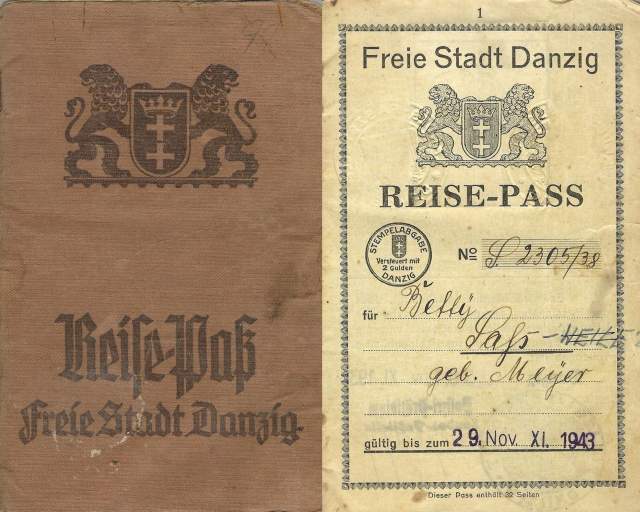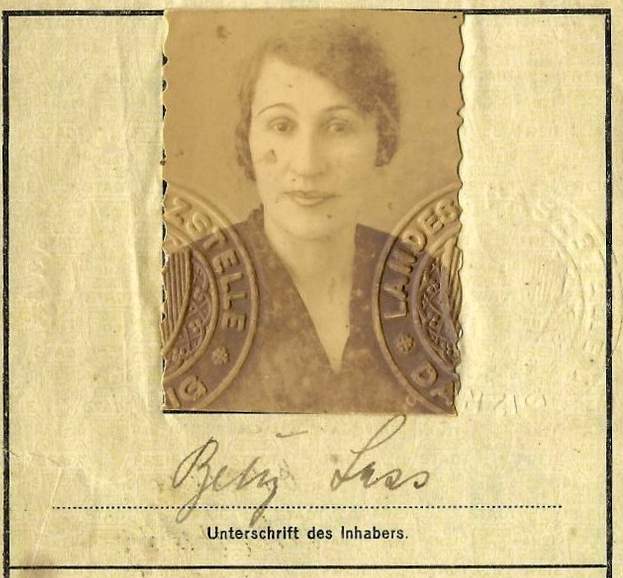Danzig Passport used in Kindertransport

This scarce travel document is currently offered online and is most likely a unique document of its kind. To my knowledge, no similar document exists in any Holocaust-related museum. The price seems high initially, but considering the item’s uniqueness, I would say it’s justified. Danzig Passport Kindertransport
Background
Nine months before the Second World War broke out, a coordinated attempt to evacuate children from areas under Nazi authority was known as the Kindertransport (German for “children’s transport”). Nearly 10,000 predominantly Jewish children from Germany, Austria, Czechoslovakia, Poland, and the Free City of Danzig were adopted by the United Kingdom. The kids were assigned to British farms, orphanages, schools, and hostels. They frequently represented the only survivors from their families during the Holocaust. The British government fostered, promoted, and supported the program. It is significant to note that the British government relaxed the visa immigration restrictions that the British Jewish community could not satisfy. The British government did not impose a cap on the program’s enrollment; instead, it ran until the Second World War broke out, and roughly 10,000 Kindertransport children had been brought to the country. Danzig Passport Kindertransport
The Netherlands, Belgium, France, Sweden, and Switzerland accepted fewer children through the program. The phrase “Kindertransport” is occasionally used to describe the evacuation of mainly Jewish children from Nazi Germany, Austria, and Czechoslovakia to the Netherlands, Belgium, and France without their parents. One instance is the 1,000 children from Chateau de La Hille who visited Belgium. However, the organized program in the U.K. is frequently referred to as the “Kindertransport.”
The Central British Fund for German Jewry (now World Jewish Relief) was founded in 1933 to provide for the needs of Jews in Germany and Austria in every feasible way. The Wagner-Rogers Bill, which sought to boost the immigration quota by bringing 20,000 additional Jewish children to the country, was introduced in Congress but died in committee due to Senator Robert Rice Reynolds’ resistance. Danzig Passport Kindertransport
The Passport Holder
 BETTY SASS (WEILE), accompanying the first Kindertransport out of Danzig, May 5, 1939, to the U.K. via the Netherlands. She was a widow from Zopott, age 39. Betty returned to Danzig after the children reached London, arriving at Harwich. The exit visa from Danzig 1940 has rare revenue stamps; they were used for several weeks only; therefore, they are tough to find. She was on one of these ships: SS Pacific, SS Milos, or S.S. Atlantic. The Hagana sank the first ship in an attempt to have them from being deported. What makes this passport extremely rare and vital are four main points:
BETTY SASS (WEILE), accompanying the first Kindertransport out of Danzig, May 5, 1939, to the U.K. via the Netherlands. She was a widow from Zopott, age 39. Betty returned to Danzig after the children reached London, arriving at Harwich. The exit visa from Danzig 1940 has rare revenue stamps; they were used for several weeks only; therefore, they are tough to find. She was on one of these ships: SS Pacific, SS Milos, or S.S. Atlantic. The Hagana sank the first ship in an attempt to have them from being deported. What makes this passport extremely rare and vital are four main points:
- Danzig passport type
- Kindertransport-visa for accompanying seventy-five children
- Internment on the Island of Mauritius
- A museum piece at its finest
Betty was interned on the Island of Mauritius from the end of 1940 to August 1945. After the war, she used the same passport to enter Haifa.

The ships above were purchased by Eichman’s “Jewish man” in Vienna, Berthold Storfer, whose tragic fate was not avoidable at the end when he pleaded with his former boss not to be deported. Storfer helped 2042 Austrian and 7054 German and other Jews, a total of 9096 people, to escape from the so-called “Final Solution.” Later, Bulgarian Jewish activist Dr. Baruch Konfino bought them and saved 2662 Jews while arranging his life-saving missions from Bulgaria.
The Passport
P.S. In 2012, I met William Kaczynski in London; he fleed NS-Germany with his mother and his child passport with a big red J-stamp to the U.K. He was a friend of Sir Nicholas Winton. Hence, I could listen to a first-hand story of “Fleeing from the Fuhrer”. Danzig Passport Kindertransport
FAQ Passport History
Passport collection, passport renewal, old passports for sale, vintage passport, emergency passport renewal, same day passport, passport application, pasaporte passeport паспорт 护照 パスポート جواز سفر पासपोर्ट
1. What are the earliest known examples of passports, and how have they evolved?
The word "passport" came up only in the mid 15th Century. Before that, such documents were safe conducts, recommendations or protection letters. On a practical aspect, the earliest passport I have seen was from the mid 16th Century. Read more...
2. Are there any notable historical figures or personalities whose passports are highly sought after by collectors?
Every collector is doing well to define his collection focus, and yes, there are collectors looking for Celebrity passports and travel documents of historical figures like Winston Churchill, Brothers Grimm, Johann Wolfgang von Goethe. Read more...
3. How did passport designs and security features change throughout different periods in history, and what impact did these changes have on forgery prevention?
"Passports" before the 18th Century had a pure functional character. Security features were, in the best case, a watermark and a wax seal. Forgery, back then, was not an issue like it is nowadays. Only from the 1980s on, security features became a thing. A state-of-the-art passport nowadays has dozens of security features - visible and invisible. Some are known only by the security document printer itself. Read more...
4. What are some of the rarest and most valuable historical passports that have ever been sold or auctioned?
Lou Gehrig, Victor Tsoi, Marilyn Monroe, James Joyce, and Albert Einstein when it comes to the most expensive ones. Read more...
5. How do diplomatic passports differ from regular passports, and what makes them significant to collectors?
Such documents were often held by officials in high ranks, like ambassadors, consuls or special envoys. Furthermore, these travel documents are often frequently traveled. Hence, they hold a tapestry of stamps or visas. Partly from unusual places.
6. Can you provide insights into the stories behind specific historical passports that offer unique insights into past travel and migration trends?
A passport tells the story of its bearer and these stories can be everything - surprising, sad, vivid. Isabella Bird and her travels (1831-1904) or Mary Kingsley, a fearless Lady explorer.
7. What role did passports play during significant historical events, such as wartime travel restrictions or international treaties?
During war, a passport could have been a matter of life or death. Especially, when we are looking into WWII and the Holocaust. And yes, during that time, passports and similar documents were often forged to escape and save lives. Example...
8. How has the emergence of digital passports and biometric identification impacted the world of passport collecting?
Current modern passports having now often a sparkling, flashy design. This has mainly two reasons. 1. Improved security and 2. Displaying a countries' heritage, icons, and important figures or achievements. I can fully understand that those modern documents are wanted, especially by younger collectors.
9. Are there any specialized collections of passports, such as those from a specific country, era, or distinguished individuals?
Yes, the University of Western Sidney Library has e.g. a passport collection of the former prime minister Hon Edward Gough Whitlam and his wife Margaret. They are all diplomatic passports and I had the pleasure to apprise them. I hold e.g. a collection of almost all types of the German Empire passports (only 2 types are still missing). Also, my East German passport collection is quite extensive with pretty rare passport types.
10. Where can passport collectors find reliable resources and reputable sellers to expand their collection and learn more about passport history?
A good start is eBay, Delcampe, flea markets, garage or estate sales. The more significant travel documents you probably find at the classic auction houses. Sometimes I also offer documents from my archive/collection. See offers... As you are already here, you surely found a great source on the topic 😉
Other great sources are: Scottish Passports, The Nansen passport, The secret lives of diplomatic couriers
11. Is vintage passport collecting legal? What are the regulations and considerations collectors should know when acquiring historical passports?
First, it's important to stress that each country has its own laws when it comes to passports. Collecting old vintage passports for historical or educational reasons is safe and legal, or at least tolerated. More details on the legal aspects are here...
Does this article spark your curiosity about passport collecting and the history of passports? With this valuable information, you have a good basis to start your own passport collection.
Question? Contact me...








